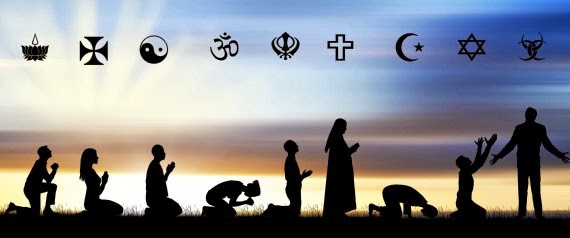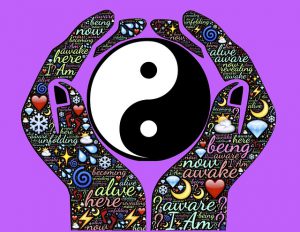
What is Religion?
religion: noun
the belief in and worship of a superhuman controlling power, especially a personal God or gods.
“ideas about the relationship between science and religion”
synonyms: faith, belief, divinity, worship, creed, teaching, doctrine, theology;
More a particular system of faith and worship.
plural noun: religions

From The Editors of Encyclopaedia Britannica:
Religion, human beings’ relation to that which they regard as holy, sacred, absolute, spiritual, divine, or worthy of especial reverence. It is also commonly regarded as consisting of the way people deal with ultimate concerns about their lives and their fate after death. In many traditions, this relation and these concerns are expressed in terms of one’s relationship with or attitude toward gods or spirits; in more humanistic or naturalistic forms of religion, they are expressed in terms of one’s relationship with or attitudes toward the broader human community or the natural world. In many religions, texts are deemed to have scriptural status, and people are esteemed to be invested with spiritual or moral authority. Believers and worshippers participate in and are often enjoined to perform devotional or contemplative practices such as prayer, meditation, or particular rituals. Worship, moral conduct, right belief, and participation in religious institutions are among the constituent elements of the religious life.

From Wikipedia:
Religion is a social-cultural system of designated behaviors and practices, morals, worldviews, texts, sanctified places, prophecies, ethics, or organizations, that relates humanity to supernatural, transcendental, or spiritual elements. However, there is no scholarly consensus over what precisely constitutes a religion.
Different religions may or may not contain various elements ranging from the divine, sacred things, faith, a supernatural being or supernatural beings or “some sort of ultimacy and transcendence that will provide norms and power for the rest of life”. Religious practices may include rituals, sermons, commemoration or veneration (of deities), sacrifices, festivals, feasts, trances, initiations, funerary services, matrimonial services, meditation, prayer, music, art, dance, public service, or other aspects of human culture. Religions have sacred histories and narratives, which may be preserved in sacred scriptures, and symbols and holy places, that aim mostly to give a meaning to life. Religions may contain symbolic stories, which are sometimes said by followers to be true, that have the side purpose of explaining the origin of life, the universe, and other things. Traditionally, faith, in addition to reason, has been considered a source of religious beliefs.
There are an estimated 10,000 distinct religions worldwide, but about 84% of the world’s population is affiliated with one of the five largest religion groups, namely Christianity, Islam, Hinduism, Buddhism or forms of folk religion. The religiously unaffiliated demographic includes those who do not identify with any particular religion, atheists, and agnostics. While the religiously unaffiliated have grown globally, many of the religiously unaffiliated still have various religious beliefs.
The study of religion encompasses a wide variety of academic disciplines, including theology, comparative religion and social scientific studies. Theories of religion offer various explanations for the origins and workings of religion, including the ontological foundations of religious being and belief.
Demographical classification
The five largest religious groups by world population, estimated to account for 5.8 billion people and 84% of the population, are Christianity, Islam, Buddhism, Hinduism (with the relative numbers for Buddhism and Hinduism dependent on the extent of syncretism) and traditional folk religion.
| Five largest religions | 2010 (billion) | 2010 (%) | 2000 (billion) | 2000 (%) | Demographics |
|---|---|---|---|---|---|
| Christianity | 2.2 | 32% | 2.0 | 33% | Christianity by country |
| Islam | 1.6 | 23% | 1.2 | 19.6% | Islam by country |
| Hinduism | 1.0 | 15% | 0.811 | 13.4% | Hinduism by country |
| Buddhism | 0.5 | 7% | 0.360 | 5.9% | Buddhism by country |
| Folk religion | 0.4 | 6% | 0.385 | 6.4% | |
| Total | 5.8 | 84% | 4.8 | 78.3% |
A global poll in 2012 surveyed 57 countries and reported that 59% of the world’s population identified as religious, 23% as not religious, 13% as convinced atheists, and also a 9% decrease in identification as religious when compared to the 2005 average from 39 countries. A follow-up poll in 2015 found that 63% of the globe identified as religious, 22% as not religious, and 11% as convinced atheists. On average, women are more religious than men. Some people follow multiple religions or multiple religious principles at the same time, regardless of whether or not the religious principles they follow traditionally allow for syncretism.
Specific Religions Traditions
Abrahamic Religions
Abrahamic religions are monotheistic religions which believe they descend from Abraham.
Judaism
The Torah is the primary sacred text of Judaism.
Judaism is the oldest Abrahamic religion, originating in the people of ancient Israel and Judea. The Torah is its foundational text, and is part of the larger text known as the Tanakh or Hebrew Bible. It is supplemented by oral tradition, set down in written form in later texts such as the Midrash and the Talmud. Judaism includes a wide corpus of texts, practices, theological positions, and forms of organization. Within Judaism there are a variety of movements, most of which emerged from Rabbinic Judaism, which holds that God revealed his laws and commandments to Moses on Mount Sinai in the form of both the Written and Oral Torah; historically, this assertion was challenged by various groups. The Jewish people were scattered after the destruction of the Temple in Jerusalem in 70 CE. Today there are about 13 million Jews, about 40 per cent living in Israel and 40 per cent in the United States. The largest Jewish religious movements are Orthodox Judaism (Haredi Judaism and Modern Orthodox Judaism), Conservative Judaism and Reform Judaism.
Christianity
Jesus is the central figure of Christianity.
Christianity is based on the life and teachings of Jesus of Nazareth (1st century) as presented in the New Testament. The Christian faith is essentially faith in Jesus as the Christ, the Son of God, and as Savior and Lord. Almost all Christians believe in the Trinity, which teaches the unity of Father, Son (Jesus Christ), and Holy Spirit as three persons in one Godhead. Most Christians can describe their faith with the Nicene Creed. As the religion of Byzantine Empire in the first millennium and of Western Europe during the time of colonization, Christianity has been propagated throughout the world. The main divisions of Christianity are, according to the number of adherents:
 The Catholic Church, led by the Bishop of Rome and the bishops worldwide in communion with him, is a communion of 24 Churches sui iuris, including the Latin Church and 23 Eastern Catholic churches, such as the Maronite Catholic Church.
The Catholic Church, led by the Bishop of Rome and the bishops worldwide in communion with him, is a communion of 24 Churches sui iuris, including the Latin Church and 23 Eastern Catholic churches, such as the Maronite Catholic Church.
Eastern Christianity, which include Eastern Orthodoxy, Oriental Orthodoxy, and the Church of the East.
Protestantism, separated from the Catholic Church in the 16th-century Protestant Reformation and is split into thousands of denominations. Major branches of Protestantism include Anglicanism, Baptists, Calvinism, Lutheranism, and Methodism, though each of these contain many different denominations or groups.
There are also smaller groups, including:
Restorationism, the belief that Christianity should be restored (as opposed to reformed) along the lines of what is known about the apostolic early church.
Latter-day Saint movement, founded by Joseph Smith in the late 1820s.
Jehovah’s Witnesses, founded in the late 1870s by Charles Taze Russell.
Islam
Islam is based on the Quran, one of the holy books considered by Muslims to be revealed by God, and on the teachings (hadith) of the Islamic prophet Muhammad, a major political and religious figure of the 7th century CE. Islam is based on the unity of all religious philosophies and accepts all of the Abrahamic prophets of Judaism, Christianity and other Abrahamic religions before Muhammad. It is the most widely practiced religion of Southeast Asia, North Africa, Western Asia, and Central Asia, while Muslim-majority countries also exist in parts of South Asia, Sub-Saharan Africa, and Southeast Europe. There are also several Islamic republics, including Iran, Pakistan, Mauritania, and Afghanistan.
 Sunni Islam is the largest denomination within Islam and follows the Quran, the hadiths which record the sunnah, whilst placing emphasis on the sahabah.
Sunni Islam is the largest denomination within Islam and follows the Quran, the hadiths which record the sunnah, whilst placing emphasis on the sahabah.
Shia Islam is the second largest denomination of Islam and its adherents believe that Ali succeeded Muhammad and further places emphasis on Muhammad’s family.
Ahmadiyya adherents believe that the awaited Imam Mahdi and the Promised Messiah has arrived, believed to be Mirza Ghulam Ahmad by Ahmadis.
There are also Muslim revivalist movements such as Muwahhidism and Salafism.
Other denominations of Islam include Nation of Islam, Ibadi, Sufism, Quranism, Mahdavia, and non-denominational Muslims. Wahhabism is the dominant Muslim schools of thought in the Kingdom of Saudi Arabia.
Other
Whilst Judaism, Christianity and Islam are commonly seen as the three Abrahamic faiths, there are smaller and newer traditions which lay claim to the designation as well.
For example, the Bahá’í Faith is a new religious movement that has links to the major Abrahamic religions as well as other religions (e.g. of Eastern philosophy). Founded in 19th-century Iran, it teaches the unity of all religious philosophies and accepts all of the prophets of Judaism, Christianity, and Islam as well as additional prophets (Buddha, Mahavira), including its founder Bahá’u’lláh. It is an offshoot of Bábism. One of its divisions is the Orthodox Bahá’í Faith.
Even smaller regional Abrahamic groups also exist, including Samaritanism (primarily in Israel and the West Bank), the Rastafari movement (primarily in Jamaica), and Druze (primarily in Syria and Lebanon).
East Asian
East Asian religions (also known as Far Eastern religions or Taoic religions) consist of several religions of East Asia which make use of the concept of Tao (in Chinese) or Dō (in Japanese or Korean). They include:
Taoism and Confucianism
 Taoism and Confucianism, as well as Korean, Vietnamese, and Japanese religion influenced by Chinese thought.
Taoism and Confucianism, as well as Korean, Vietnamese, and Japanese religion influenced by Chinese thought.
Chinese folk religion: the indigenous religions of the Han Chinese, or, by metonymy, of all the populations of the Chinese cultural sphere. It includes the syncretism of Confucianism, Taoism and Buddhism, Wuism, as well as many new religious movements such as Chen Tao, Falun Gong and Yiguandao.
Other folk and new religions of East Asia and Southeast Asia such as Korean shamanism, Chondogyo, and Jeung San Do in Korea; Shinto, Shugendo, Ryukyuan religion, and Japanese new religions in Japan; Satsana Phi in Laos; Cao Đài, Hòa Hảo, and Vietnamese folk religion in Vietnam.
Dharmic (Indian)
Indian religions are practiced or were founded in the Indian subcontinent. They are sometimes classified as the dharmic religions, as they all feature dharma, the specific law of reality and duties expected according to the religion.
Hinduism
Hinduism is preferentially self-designated by the term Vaidika Dharma. It is a synecdoche describing the similar philosophies of Vaishnavism, Shaivism, and related groups practiced or founded in the Indian subcontinent. Concepts most of them share in common include karma, caste, reincarnation, mantras, yantras, and darśana. Hinduism is one of the most ancient of still-active religions with origins perhaps as far back as prehistoric times. Hinduism is not a monolithic religion but a religious category containing dozens of separate philosophies amalgamated as Sanātana Dharma, which is the name by which Hinduism has been known throughout history by its followers.
Jainism
 Jainism, taught primarily by Rishabhanatha (the founder of ahimsa) is an ancient Indian religion that prescribes a path of non-violence, truth and anekantavada for all forms of living beings in this universe; which helps them to eliminate all the Karmas, and hence to attain freedom from the cycle of birth and death (saṃsāra), that is, achieving nirvana. Jains are found mostly in India. According to Dundas, outside of the Jain tradition, historians date the Mahavira as about contemporaneous with the Buddha in the 5th-century BCE, and accordingly the historical Parshvanatha, based on the c. 250-year gap, is placed in 8th or 7th century BCE.
Jainism, taught primarily by Rishabhanatha (the founder of ahimsa) is an ancient Indian religion that prescribes a path of non-violence, truth and anekantavada for all forms of living beings in this universe; which helps them to eliminate all the Karmas, and hence to attain freedom from the cycle of birth and death (saṃsāra), that is, achieving nirvana. Jains are found mostly in India. According to Dundas, outside of the Jain tradition, historians date the Mahavira as about contemporaneous with the Buddha in the 5th-century BCE, and accordingly the historical Parshvanatha, based on the c. 250-year gap, is placed in 8th or 7th century BCE.
Digambara Jainism (or sky-clad) is mainly practiced in South India. Their holy books are Pravachanasara and Samayasara written by their Prophets Kundakunda and Amritchandra as their original canon is lost.
Shwetambara Jainism (or white-clad) is mainly practiced in Western India. Their holy books are Jain Agamas, written by their Prophet Sthulibhadra.
Buddhism
 Buddhism was founded by Siddhartha Gautama in the 6th century BCE. Buddhists generally agree that Gotama aimed to help sentient beings end their suffering (dukkha) by understanding the true nature of phenomena, thereby escaping the cycle of suffering and rebirth (saṃsāra), that is, achieving nirvana.
Buddhism was founded by Siddhartha Gautama in the 6th century BCE. Buddhists generally agree that Gotama aimed to help sentient beings end their suffering (dukkha) by understanding the true nature of phenomena, thereby escaping the cycle of suffering and rebirth (saṃsāra), that is, achieving nirvana.
Theravada Buddhism, which is practiced mainly in Sri Lanka and Southeast Asia alongside folk religion, shares some characteristics of Indian religions. It is based in a large collection of texts called the Pali Canon.
Mahayana Buddhism (or the Great Vehicle) under which are a multitude of doctrines that became prominent in China and are still relevant in Vietnam, Korea, Japan and to a lesser extent in Europe and the United States. Mahayana Buddhism includes such disparate teachings as Zen, Pure Land, and Soka Gakkai.
Vajrayana Buddhism first appeared in India in the 3rd century CE. It is currently most prominent in the Himalaya regions and extends across all of Asia.
Two notable new Buddhist sects are Hòa Hảo and the Navayana (Dalit Buddhist movement), which were developed separately in the 20th century.
Sikhism
 Sikhism is a panentheistic religion founded on the teachings of Guru Nanak and ten successive Sikh gurus in 15th-century Punjab. It is the fifth-largest organized religion in the world, with approximately 30 million Sikhs. Sikhs are expected to embody the qualities of a Sant-Sipāhī—a saint-soldier, have control over one’s internal vices and be able to be constantly immersed in virtues clarified in the Guru Granth Sahib. The principal beliefs of Sikhi are faith in Waheguru—represented by the phrase ik ōaṅkār, meaning one God, who prevails in everything, along with a praxis in which the Sikh is enjoined to engage in social reform through the pursuit of justice for all human beings.
Sikhism is a panentheistic religion founded on the teachings of Guru Nanak and ten successive Sikh gurus in 15th-century Punjab. It is the fifth-largest organized religion in the world, with approximately 30 million Sikhs. Sikhs are expected to embody the qualities of a Sant-Sipāhī—a saint-soldier, have control over one’s internal vices and be able to be constantly immersed in virtues clarified in the Guru Granth Sahib. The principal beliefs of Sikhi are faith in Waheguru—represented by the phrase ik ōaṅkār, meaning one God, who prevails in everything, along with a praxis in which the Sikh is enjoined to engage in social reform through the pursuit of justice for all human beings.
Indigenous religions
Indigenous religions or folk religions refers to a broad category of traditional religions that can be characterised by shamanism, animism and ancestor worship, where traditional means “indigenous, that which is aboriginal or foundational, handed down from generation to generation…”. These are religions that are closely associated with a particular group of people, ethnicity or tribe; they often have no formal creeds or sacred texts. Some faiths are syncretic, fusing diverse religious beliefs and practices.
Australian Aboriginal religions.
Folk religions of the Americas: Native American religions
Folk religions are often omitted as a category in surveys even in countries where they are widely practiced, e.g. in China.
Traditional African
 African traditional religion encompasses the traditional religious beliefs of people in Africa. In West Africa, these religions include the Akan religion, Dahomey (Fon) mythology, Efik mythology, Odinani, Serer religion (A ƭat Roog), and Yoruba religion, while Bushongo mythology, Mbuti (Pygmy) mythology, Lugbara mythology, Dinka religion, and Lotuko mythology come from central Africa. Southern African traditions include Akamba mythology, Masai mythology, Malagasy mythology, San religion, Lozi mythology, Tumbuka mythology, and Zulu mythology. Bantu mythology is found throughout central, southeast, and southern Africa. In north Africa, these traditions include Berber and ancient Egyptian.
African traditional religion encompasses the traditional religious beliefs of people in Africa. In West Africa, these religions include the Akan religion, Dahomey (Fon) mythology, Efik mythology, Odinani, Serer religion (A ƭat Roog), and Yoruba religion, while Bushongo mythology, Mbuti (Pygmy) mythology, Lugbara mythology, Dinka religion, and Lotuko mythology come from central Africa. Southern African traditions include Akamba mythology, Masai mythology, Malagasy mythology, San religion, Lozi mythology, Tumbuka mythology, and Zulu mythology. Bantu mythology is found throughout central, southeast, and southern Africa. In north Africa, these traditions include Berber and ancient Egyptian.
There are also notable African diasporic religions practiced in the Americas, such as Santeria, Candomble, Vodun, Lucumi, Umbanda, and Macumba.
Iranian
 Iranian religions are ancient religions whose roots predate the Islamization of Greater Iran. Nowadays these religions are practiced only by minorities.
Iranian religions are ancient religions whose roots predate the Islamization of Greater Iran. Nowadays these religions are practiced only by minorities.
Zoroastrianism is based on the teachings of prophet Zoroaster in the 6th century BCE. Zoroastrians worship the creator Ahura Mazda. In Zoroastrianism, good and evil have distinct sources, with evil trying to destroy the creation of Mazda, and good trying to sustain it.
Mandaeism is a monotheistic religion with a strongly dualistic worldview. Mandaeans are sometime labeled as the Last Gnostics.
Kurdish religions include the traditional beliefs of the Yazidi, Alevi, and Ahl-e Haqq. Sometimes these are labeled Yazdânism.
Features
Copyright © 2018 SEAN-O-VISTA

Powered with 



